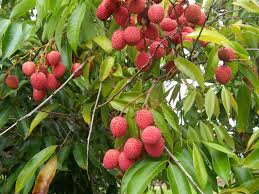Lychees scientifically known as Litchi chinensis are tasty fruits that come from a tree called Litchi chinensis. These fruits have a rough, red, or pinkish shell that needs to be peeled to reveal the juicy and sweet flesh inside. People love lychees for their delightful taste and unique texture.
These fruits are native to Southeast Asia but are now grown in various parts of the world. Lychee trees thrive in warm climates, making them popular in tropical regions. The fruit has a distinct floral aroma that adds to its overall appeal.
When you bite into a lychee, you’ll discover a burst of sweetness with a hint of floral notes. The texture is like a juicy grape, and the flavor is so delightful that many people consider lychees a special treat.
Not only are lychees delicious, but they also offer some health benefits. They are a good source of vitamin C, which helps boost the immune system. Additionally, lychees contain antioxidants that may contribute to overall well-being.
In some cultures, lychees hold special significance. They are often associated with celebrations and festivals, symbolizing good luck and prosperity. The vibrant red color of the lychee shell is believed to bring positive energy.
In culinary terms, lychees can be enjoyed in various ways. Some people prefer to eat them fresh, while others use them in salads, desserts, or as a topping for ice cream. Lychee-flavored beverages and cocktails are also popular, showcasing the fruit’s versatility.
It’s fascinating to note that lychees have a long history, with records of their cultivation dating back thousands of years. Over time, different varieties of lychees have emerged, each with its own unique flavor profile and characteristics.
In addition, lychees are not just fruits; they are a delightful experience. From their exotic origin to their sweet and juicy taste, lychees have captivated people’s palates for generations. Whether enjoyed fresh or incorporated into various dishes, these fruits continue to be a symbol of joy and good fortune in many cultures around the world.
Read Also: Coccidiosis in Poultry: Signs, Drugs and Treatment
The History of Lychees (Litchi chinensis)

The history of lychees traces back centuries, originating in Southeast Asia. The lychee tree, scientifically known as Litchi chinensis, is believed to have been cultivated in China for over 2,000 years. The fruit’s journey from its native region to becoming a global favorite is an interesting tale.
Lychees were initially cultivated in the southern provinces of China, and historical records suggest that they were cherished by the Chinese nobility during the Tang Dynasty (618-907 AD). The fruit was not only appreciated for its delectable taste but also gained cultural significance, often associated with good luck and fortune.
As trade routes expanded, lychees gradually spread to other parts of Asia. They found their way to countries like India, Malaysia, and Vietnam. The fruit’s popularity continued to grow, becoming a staple in the diets of many cultures.
In the 18th century, lychees made their way to the West. European explorers and traders encountered the fruit during their journeys in Asia, introducing it to a wider audience. However, due to the delicate nature of lychees, their cultivation in non-native regions proved challenging.
The 19th century saw successful attempts to cultivate lychees in other tropical regions, such as the Caribbean, Central America, and parts of Africa. The fruit adapted well to these climates, enabling its cultivation beyond its Asian origins. Lychees then started to capture the taste buds of people around the world.
Today, lychees are grown in various tropical and subtropical regions, including parts of the United States, Australia, and the Middle East. Improved transportation and agricultural practices have facilitated the global availability of lychees, making them a popular and sought-after fruit in many markets.
The journey of lychees from a regional delicacy in China to a globally cherished fruit reflects not only their delicious taste but also the interconnected history of trade, exploration, and cultural exchange. The rich history of lychees adds an extra layer of fascination to the enjoyment of this unique and flavorful fruit.
The Nutritional Value of Lychees (Litchi chinensis)

Lychees are not only delicious but also offer various nutritional benefits. Here’s a glimpse into the nutritional value of these delectable fruits:
1. Vitamins: Lychees are a good source of vitamin C, providing a significant portion of the recommended daily intake. Vitamin C is essential for a healthy immune system, skin, and overall well-being.
2. Antioxidants: These fruits contain antioxidants, including polyphenols and flavonoids. Antioxidants help protect the body’s cells from damage caused by free radicals, contributing to overall health.
3. Dietary Fiber: Lychees are a decent source of dietary fiber, which aids in digestion and helps maintain a healthy digestive system. Fiber also contributes to a feeling of fullness, which can be beneficial for those looking to manage their weight.
4. B Vitamins: Lychees contain several B vitamins, including thiamine, riboflavin, niacin, vitamin B6, folate, and pantothenic acid. These vitamins play crucial roles in energy metabolism and maintaining the health of the nervous system.
5. Minerals: Lychees provide essential minerals such as potassium, copper, phosphorus, magnesium, manganese, and zinc. These minerals are vital for various bodily functions, including bone health, electrolyte balance, and enzyme activity.
6. Low in Calories: Lychees are relatively low in calories, making them a healthy snack option. They offer a sweet and satisfying flavor without excessive caloric intake.
It’s important to note that while lychees offer numerous nutritional benefits, moderation is key. Like any fruit, they should be part of a balanced diet. Including a variety of fruits and vegetables ensures a diverse range of nutrients, promoting overall health and well-being.
Read Also: A Step-by-Step Guide To Raising Backyard Chickens
The Health Benefits of Lychees (Litchi chinensis)

Lychees come with a range of health benefits, making them a delightful addition to a balanced diet. Here are some of the notable health benefits associated with consuming lychees:
1. Immune System Support: Rich in vitamin C, lychees contribute to a healthy immune system. Vitamin C is known for its role in supporting the body’s defense against infections and illnesses.
2. Antioxidant Protection: Lychees contain antioxidants, including polyphenols and flavonoids. These antioxidants help neutralize free radicals in the body, potentially reducing the risk of chronic diseases and promoting overall health.
3. Digestive Health: The dietary fiber in lychees supports digestive health by promoting regular bowel movements and preventing constipation. Adequate fiber intake is essential for a well-functioning digestive system.
4. Heart Health: Potassium, a mineral present in lychees, plays a key role in maintaining a healthy heart. It helps regulate blood pressure, reducing the risk of cardiovascular issues.
5. Hydration: Lychees have high water content, contributing to overall hydration. Staying hydrated is essential for various bodily functions, including maintaining skin health and supporting metabolism.
6. Blood Circulation: Copper, present in lychees, is crucial for the formation of red blood cells. This mineral supports proper blood circulation and oxygenation of cells and tissues.
7. Bone Health: Lychees contain minerals such as phosphorus, magnesium, and manganese, which contribute to bone health. These minerals are essential for maintaining strong and healthy bones.
8. Weight Management: With relatively low calories and satisfying sweetness, lychees can be a healthy snack option for those looking to manage their weight. The fiber content also helps with satiety.
9. Vision Health: The presence of vitamins like vitamin A in lychees is beneficial for maintaining good vision and eye health.
It’s important to enjoy lychees as part of a varied and balanced diet to reap their full nutritional benefits. As with any food, moderation is key, and individuals with specific health concerns or conditions should consult with a healthcare professional for personalized advice.
How to Grow Lychees (Litchi chinensis)
Growing lychees can be a rewarding experience, but it’s essential to provide the right conditions for these tropical trees to thrive. Here’s a simplified guide on how to grow lychees:
1. Climate: Lychees thrive in tropical to subtropical climates. They prefer warm temperatures and are sensitive to cold. Ensure temperatures do not drop below freezing, as lychee trees are frost-sensitive.
2. Soil: Plant lychees in well-draining soil with a slightly acidic to neutral pH. Adding organic matter to the soil can improve its fertility and water retention.
3. Sunlight: Lychee trees need full sun to produce healthy fruit. Ensure they receive at least 6-8 hours of sunlight daily.
4. Planting: Plant lychee seeds or seedlings in a location with good air circulation. Dig a hole twice as wide as the root ball and at the same depth. Water the tree thoroughly after planting.
5. Watering: Keep the soil consistently moist but not waterlogged, especially during dry periods. Reduce watering during the dormant season.
6. Fertilization: Fertilize lychee trees regularly during the growing season with a balanced fertilizer. Apply a mulch layer around the base to help retain moisture and suppress weeds.
7. Pruning: Prune the tree to maintain its shape and encourage air circulation. Remove dead or damaged branches regularly.
8. Pollination: Lychees are often self-pollinating, but having multiple trees can enhance fruit production. Bees and other pollinators can assist in the pollination process.
9. Pest and Disease Control: Keep an eye out for common pests like aphids and scale insects. Apply appropriate organic or chemical controls if needed.
10. Harvesting: Lychees typically mature in late spring to early summer, depending on the variety. Harvest when the fruit is fully colored and easily comes off the tree with a gentle twist.
Growing lychees may take some patience, as it can take a few years for the tree to start bearing fruit. Additionally, specific considerations may vary depending on your local climate and soil conditions. Always consult local gardening resources or seek advice from experienced gardeners to tailor your approach to the unique conditions of your region.
Read Also: How to Graft an Avocado Tree to Produce Avocado Fruit
